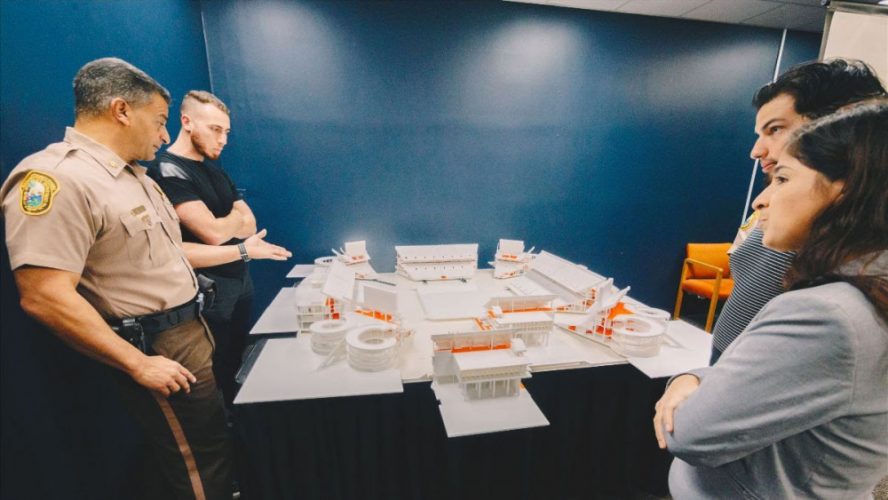Miami-Dade Police are preparing for Super Bowl LIV with a highly detailed 3D-printed model of Hard Rock Stadium, made by FIU students, that unleashed innovative opportunities for training.
“Law enforcement has never done something like this before for a Super Bowl. This is a first for us, and the students at FIU are the ones who made it happen,” said Major Edgardo Caneva, who oversees the Miami-Dade Police Department’s Special Patrol Bureau and is also the Super Bowl Operations Commander.
Caneva reached out to FIU Police Chief Alexander Casas with the idea for a 3D model. From there, College of Communication, Architecture + The Arts Dean Brian Schriner enlisted the college’s Robotics and Digital Fabrication (RDF) Lab, which is funded by the National Science Foundation, to design and create the model. The lab is an example of how the college offers its students experiential learning opportunities to work on projects that have real-world applications while training them as experts in their field.
The team that made it happen consists of Project Director Hadi Alhaffar, architecture graduate students Katherin Rendon and Francisco Alduenda, and undergraduate IT software student Samuel Morris.
The four-by-five-foot model shows bleachers, hallways, exits, rooms, and even support beams to-scale. It can be separated into sliding cross-sections for closer examination. This level of detail is the result of months spent examining rough digital diagrams, walking through foot traffic flow, fine-tuning the lab’s 3D-printers, and over 3,500 hours of printing. It is accurate down to the millimeter.
Officers from the Special Patrol Bureau, which includes the Special Response Team and the Rapid Deployment Force, have been using the model for months to get to know the 65,000-seat stadium for tactical planning and training in and around the stadium. Since mid-November, the department has been using the model to conduct table-top strategy sessions and training in preparation for the Super Bowl on Feb. 2. Having the model has saved them time traveling to and from the stadium, and also allowed more face-to-face communication among the team. The Special Patrol Bureau will also use the model for future events.
A collaboration of this nature was a first for the lab, as well.
“This was something unique, for FIU and MDPD, the creation of a physical model to use in training,” said Professor Shahin Vassigh, who is the director of the RDF Lab. “It’s not necessarily the scale that is unique – architects make models for demonstration regularly – but the intricacy of details and this type of collaboration.”
The FIU Police Department funded the project per a request for mutual aid from MDPD, said FIU Chief Alexander Casas.
“All of South Florida’s law enforcement have strong relationships and are very collaborative,” Casas said. “Miami-Dade Police have helped us out a lot, so I couldn’t say yes fast enough.”
Looking forward, the lab hopes to collaborate in different ways with FIUPD, MDPD, and agencies like it. Alhaffar mentioned augmented reality, virtual reality, and intelligent lighting as some new collaborations.
“I think it shows we aren’t afraid of trying something new, and that the university isn’t afraid to push us to do new things,” Rendon added.



